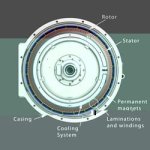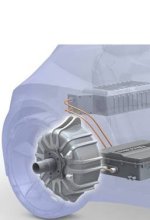Lock
100 MW
http://www.sae.org/mags/aei/SAEWC/7825
Full article in the link but some snips:
The TM4 MäTIVE permanent magnet electric motor offers advanced electric drive design to niche-sized EV manufacturers, said Eric Azeroual, TM4's business development manager. The TM4 system, a small, lightweight, and cost-efficient powerplant suitable for all-electric or plug-in hybrid vehicles, will be featured at the 2010 SAE World Congress in Detroit.
The e-motor has been available to selected customers for a little over a year. It boasts the best power-to-weight ratio in its class and industry-leading energy efficiency, according to Canada-based TM4, which is a subsidiary of Hydro-Québec, a hydroelectric power utility.
The company has capacity to produce 10,000 e-drives per year. Its motor designs range from 10 kW (for golf carts) to 660 kW (wind generation and marine applications). Prototypes of the latter are now under test.
The MäTIVE design is the result of a decade of R&D on advanced, high-performance electric motors at TM4, which made its name in the late 1990s with a innovative in-wheel or wheel hub motor developed originally by the Canadian inventor and engineer Pierre Couture.
To maximize torque, the design uses reverse-order topology, an inside-out layout wherein the rotor spins outside of the stator. This configuration increases the radius from the hub to rotor, which provides more moment or leverage, explained Azeroual.
“The advanced in-wheel motor led to numerous patents related to compact design and torque control,†he said. “When we addressed a motor for conventional applications where the power plant is located in the central part of vehicle or on the rear axle like the MäTIVE, we decided to ‘de-telescope’ the reversed configuration, but still retain the many of the best features of the earlier motor.â€Â
He cites the motor's +10,000-rpm shaft speeds as a key differentiator. "The faster a motor spins, the higher its power density, the smaller it can be and the cheaper it ends up being,†Azeroual said.
The Mä 120 system, which weighs 32 kg (70.5 lb), offers 120-kW maximum power, with 37 kW continuous power. Claimed peak torque is 170 N·m (125 lb·ft), with 78 N·m (57.7 lb·ft) continuous. It has a maximum 4.6 kW/kg power-to-weight ratio.
The motor offers 96% efficiency at nominal operation, the company claims. Cooling is provided by 40/60% water/glycol system.
Azeroual also highlighted the high packing density of the TM4 MäTIVE’s flat wire-windings.
“We have strong patents on a unique shape that results in shorter end windings, areas that don’t generate power,†he said, adding that the special shape further boosts power density and efficiency, yielding a lighter motor that produces less heat.
All TM4 products are designed to work with a "smart" charging grid.
Hydro-Québec intends to set up a joint venture with a global-scale auto parts manufacturer to facilitate the mass production and marketing of the TM4 MäTIVE electric powertrains.
“We’re looking to find a manufacturing partner to scale up production,†Azeroual reported. “Right now, we’re using our current motor production to work on continuous process improvement.â€Â
Full article in the link but some snips:
The TM4 MäTIVE permanent magnet electric motor offers advanced electric drive design to niche-sized EV manufacturers, said Eric Azeroual, TM4's business development manager. The TM4 system, a small, lightweight, and cost-efficient powerplant suitable for all-electric or plug-in hybrid vehicles, will be featured at the 2010 SAE World Congress in Detroit.
The e-motor has been available to selected customers for a little over a year. It boasts the best power-to-weight ratio in its class and industry-leading energy efficiency, according to Canada-based TM4, which is a subsidiary of Hydro-Québec, a hydroelectric power utility.
The company has capacity to produce 10,000 e-drives per year. Its motor designs range from 10 kW (for golf carts) to 660 kW (wind generation and marine applications). Prototypes of the latter are now under test.
The MäTIVE design is the result of a decade of R&D on advanced, high-performance electric motors at TM4, which made its name in the late 1990s with a innovative in-wheel or wheel hub motor developed originally by the Canadian inventor and engineer Pierre Couture.
To maximize torque, the design uses reverse-order topology, an inside-out layout wherein the rotor spins outside of the stator. This configuration increases the radius from the hub to rotor, which provides more moment or leverage, explained Azeroual.
“The advanced in-wheel motor led to numerous patents related to compact design and torque control,†he said. “When we addressed a motor for conventional applications where the power plant is located in the central part of vehicle or on the rear axle like the MäTIVE, we decided to ‘de-telescope’ the reversed configuration, but still retain the many of the best features of the earlier motor.â€Â
He cites the motor's +10,000-rpm shaft speeds as a key differentiator. "The faster a motor spins, the higher its power density, the smaller it can be and the cheaper it ends up being,†Azeroual said.
The Mä 120 system, which weighs 32 kg (70.5 lb), offers 120-kW maximum power, with 37 kW continuous power. Claimed peak torque is 170 N·m (125 lb·ft), with 78 N·m (57.7 lb·ft) continuous. It has a maximum 4.6 kW/kg power-to-weight ratio.
The motor offers 96% efficiency at nominal operation, the company claims. Cooling is provided by 40/60% water/glycol system.
Azeroual also highlighted the high packing density of the TM4 MäTIVE’s flat wire-windings.
“We have strong patents on a unique shape that results in shorter end windings, areas that don’t generate power,†he said, adding that the special shape further boosts power density and efficiency, yielding a lighter motor that produces less heat.
All TM4 products are designed to work with a "smart" charging grid.
Hydro-Québec intends to set up a joint venture with a global-scale auto parts manufacturer to facilitate the mass production and marketing of the TM4 MäTIVE electric powertrains.
“We’re looking to find a manufacturing partner to scale up production,†Azeroual reported. “Right now, we’re using our current motor production to work on continuous process improvement.â€Â



